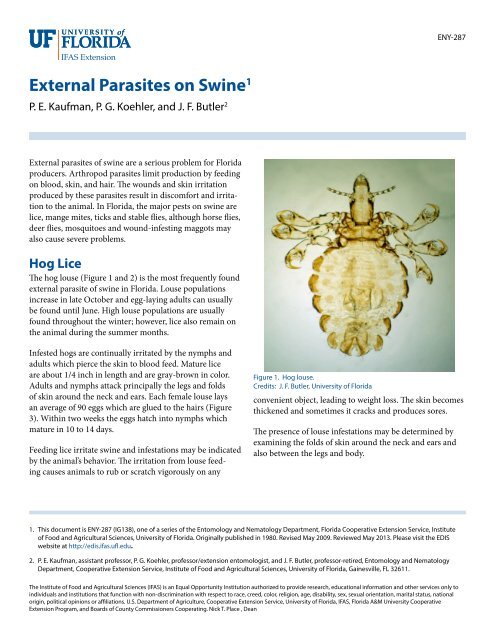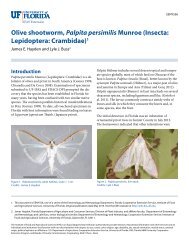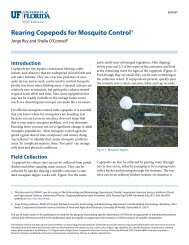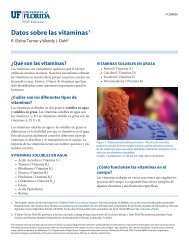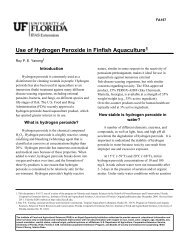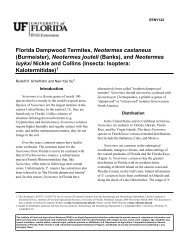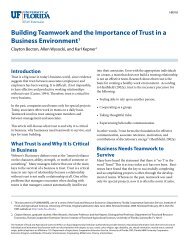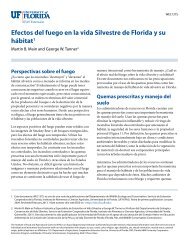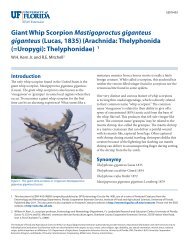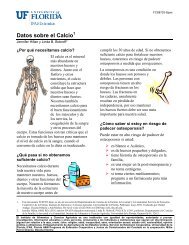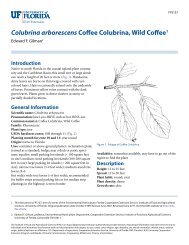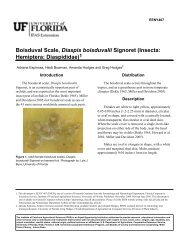Download PDF - EDIS - University of Florida
Download PDF - EDIS - University of Florida
Download PDF - EDIS - University of Florida
Create successful ePaper yourself
Turn your PDF publications into a flip-book with our unique Google optimized e-Paper software.
ENY-287<br />
External Parasites on Swine 1<br />
P. E. Kaufman, P. G. Koehler, and J. F. Butler 2<br />
External parasites <strong>of</strong> swine are a serious problem for <strong>Florida</strong><br />
producers. Arthropod parasites limit production by feeding<br />
on blood, skin, and hair. The wounds and skin irritation<br />
produced by these parasites result in discomfort and irritation<br />
to the animal. In <strong>Florida</strong>, the major pests on swine are<br />
lice, mange mites, ticks and stable flies, although horse flies,<br />
deer flies, mosquitoes and wound-infesting maggots may<br />
also cause severe problems.<br />
Hog Lice<br />
The hog louse (Figure 1 and 2) is the most frequently found<br />
external parasite <strong>of</strong> swine in <strong>Florida</strong>. Louse populations<br />
increase in late October and egg-laying adults can usually<br />
be found until June. High louse populations are usually<br />
found throughout the winter; however, lice also remain on<br />
the animal during the summer months.<br />
Infested hogs are continually irritated by the nymphs and<br />
adults which pierce the skin to blood feed. Mature lice<br />
are about 1/4 inch in length and are gray-brown in color.<br />
Adults and nymphs attack principally the legs and folds<br />
<strong>of</strong> skin around the neck and ears. Each female louse lays<br />
an average <strong>of</strong> 90 eggs which are glued to the hairs (Figure<br />
3). Within two weeks the eggs hatch into nymphs which<br />
mature in 10 to 14 days.<br />
Feeding lice irritate swine and infestations may be indicated<br />
by the animal’s behavior. The irritation from louse feeding<br />
causes animals to rub or scratch vigorously on any<br />
Figure 1. Hog louse.<br />
Credits: J. F. Butler, <strong>University</strong> <strong>of</strong> <strong>Florida</strong><br />
convenient object, leading to weight loss. The skin becomes<br />
thickened and sometimes it cracks and produces sores.<br />
The presence <strong>of</strong> louse infestations may be determined by<br />
examining the folds <strong>of</strong> skin around the neck and ears and<br />
also between the legs and body.<br />
1. This document is ENY-287 (IG138), one <strong>of</strong> a series <strong>of</strong> the Entomology and Nematology Department, <strong>Florida</strong> Cooperative Extension Service, Institute<br />
<strong>of</strong> Food and Agricultural Sciences, <strong>University</strong> <strong>of</strong> <strong>Florida</strong>. Originally published in 1980. Revised May 2009. Reviewed May 2013. Please visit the <strong>EDIS</strong><br />
website at http://edis.ifas.ufl.edu.<br />
2. P. E. Kaufman, assistant pr<strong>of</strong>essor, P. G. Koehler, pr<strong>of</strong>essor/extension entomologist, and J. F. Butler, pr<strong>of</strong>essor-retired, Entomology and Nematology<br />
Department, Cooperative Extension Service, Institute <strong>of</strong> Food and Agricultural Sciences, <strong>University</strong> <strong>of</strong> <strong>Florida</strong>, Gainesville, FL 32611.<br />
The Institute <strong>of</strong> Food and Agricultural Sciences (IFAS) is an Equal Opportunity Institution authorized to provide research, educational information and other services only to<br />
individuals and institutions that function with non-discrimination with respect to race, creed, color, religion, age, disability, sex, sexual orientation, marital status, national<br />
origin, political opinions or affiliations. U.S. Department <strong>of</strong> Agriculture, Cooperative Extension Service, <strong>University</strong> <strong>of</strong> <strong>Florida</strong>, IFAS, <strong>Florida</strong> A&M <strong>University</strong> Cooperative<br />
Extension Program, and Boards <strong>of</strong> County Commissioners Cooperating. Nick T. Place , Dean
Mange<br />
Mange in swine is caused by mange mites. Two principal<br />
types <strong>of</strong> mange mites are found in <strong>Florida</strong>.<br />
Itch mites (Sarcoptic Mange (Figure 2)) burrow just<br />
beneath the skin making slender, winding tunnels from<br />
0.1 to 1 inch long. Fluid discharged at the tunnel opening<br />
dries to form nodules. A toxin is also secreted which causes<br />
intense irritation and itching. Infested animals rub and<br />
scratch constantly producing inflamed areas which may<br />
spread over the entire body. Infestations are contagious and<br />
treatment <strong>of</strong> all animals in a herd is essential to prevent<br />
transmission.<br />
To make a positive identification <strong>of</strong> mange, scrape the edge<br />
or margin <strong>of</strong> suspected areas with a dull knife until bleeding<br />
starts or scrape contents <strong>of</strong> pustules. Examine scrapings<br />
under magnification.<br />
Figure 3. Demodectic mange mite.<br />
Credits: J. F. Butler, <strong>University</strong> <strong>of</strong> <strong>Florida</strong><br />
Figure 2. Itch mange mite.<br />
Credits: J. F. Butler, <strong>University</strong> <strong>of</strong> <strong>Florida</strong><br />
When mange is suspected, protect yourself from contamination.<br />
Mange can be transmitted to humans. After<br />
handling infested hogs, wash clothing in hot soapy water<br />
and shower thoroughly.<br />
Follicular mites (Demodectic Mange) (Figure 3) are microscopic,<br />
cigar-shaped mites that also live in the skin. All<br />
life stages are found in the hair follicle. The mite produces<br />
nodular lesions which sometimes break, producing holes in<br />
the hide. Control is difficult since the mites are located deep<br />
in the hide.<br />
Ticks<br />
Several species <strong>of</strong> ticks may attack swine. These fall under<br />
two general groups, hard and s<strong>of</strong>t ticks. Hard ticks are the<br />
most important group to attack swine. Hard ticks have<br />
a long association with the host, feed slowly, take a large<br />
blood meal, drop from the host to molt, and lay many eggs.<br />
Typical representatives are the American dog tick (Figure<br />
4), brown dog tick, Gulf Coast tick (Figure 5), and rocky<br />
mountain wood tick.<br />
S<strong>of</strong>t ticks (Figure 6) are <strong>of</strong> less importance to hogs. S<strong>of</strong>t<br />
ticks feed rapidly while a host animal is resting and then<br />
leave. A typical s<strong>of</strong>t tick is the spinose ear tick.<br />
The effects <strong>of</strong> ticks on swine are inflammation, itching and<br />
swelling at the bite site. Wounds may become infected.<br />
Ticks are typically a problem on hogs that are allowed to<br />
roam in wooded areas.<br />
Excessive scratching and rubbing may be an indication <strong>of</strong><br />
mange. Follicular mange may produce inflamed areas and<br />
pustules on the belly, the head and top <strong>of</strong> the neck.<br />
External Parasites on Swine<br />
2
Stable Flies<br />
The stable fly (Figure 7) is similar to the house fly in size<br />
and color, but the bayonet-like mouthparts for sucking<br />
blood differentiate it. Stable fly bites cause irritation to<br />
animals and may account for much blood loss in severe<br />
cases. Wounds from bites may become infected. Stable flies<br />
are proven vectors <strong>of</strong> swine diseases such as hog cholera<br />
and leptospirosis.<br />
Figure 4. American dog tick.<br />
Credits: J. F. Butler, <strong>University</strong> <strong>of</strong> <strong>Florida</strong><br />
Stable flies breed in soggy hay, grain or feed, piles <strong>of</strong> moist<br />
fermenting weeds, spilled green chop, peanut litter, and in<br />
manure mixed with hay or straw.<br />
Stable fly control is most successfully approached by<br />
cultural control measures. The larvae require a moist<br />
breeding media. Therefore, the source <strong>of</strong> breeding should<br />
be dispersed to allow drying <strong>of</strong>ten enough to break the life<br />
cycle.<br />
Figure 5. Gulf Coast tick.<br />
Credits: J. F. Butler, <strong>University</strong> <strong>of</strong> <strong>Florida</strong><br />
Figure 8. Stable fly.<br />
Credits: J. F. Butler, <strong>University</strong> <strong>of</strong> <strong>Florida</strong><br />
Sticktight Flea<br />
The sticktight flea (Figure 9) is an important pest <strong>of</strong> swine<br />
in <strong>Florida</strong>. Although the flea is mainly considered to be a<br />
pest <strong>of</strong> poultry, the ears <strong>of</strong> hogs may <strong>of</strong>ten become lined<br />
with them.<br />
Figure 6. S<strong>of</strong>t tick, O. turicata.<br />
Credits: J. F. Butler, <strong>University</strong> <strong>of</strong> <strong>Florida</strong><br />
Adult fleas line the ears <strong>of</strong> swine where they feed on blood<br />
and remain attached for several weeks. While feeding, the<br />
female lays eggs which fall to the ground. The eggs hatch<br />
and the larvae feed on organic matter in dry protected<br />
places. Within one month the larvae pupate and transform<br />
to adults.<br />
Adult fleas feeding in the ears may cause ulceration and<br />
secondary infection.<br />
External Parasites on Swine<br />
3
Selected References<br />
Dee, S.A., J.A. Schurrer, R.D. Moon, E. Fano, C. Trincado,<br />
and C. Pijoan. 2004. Transmission <strong>of</strong> porcine reproductive<br />
and respiratory syndrome virus under field conditions<br />
during a putative increase in the fly population. J. Swine<br />
Health Prod. 12: 242-445.<br />
Gore, J.C., L. Zurek, R.G. Santangelo, S.M. Stringham, D.W.<br />
Watson and C. Schal. 2004. Water solutions boric acid and<br />
sugar for management <strong>of</strong> German cockroach populations<br />
in livestock production systems. J. Econ. Entomol. 97:<br />
715-720.<br />
Mercier, P., C. F. Cargill, and C. R. White. 2002. Preventing<br />
transmission <strong>of</strong> sarcoptic mange from sows to their<br />
<strong>of</strong>fspring by injection <strong>of</strong> ivermectin: Effects on swine<br />
production. Vet. Parasit. 110: 25-33.<br />
Figure 9. Sticktight flea.<br />
Credits: J. F. Butler, <strong>University</strong> <strong>of</strong> <strong>Florida</strong><br />
Keys To Pesticide Safety<br />
1. Before using any pesticide, stop and read the precautions.<br />
2. Read the level on each pesticide container before each<br />
use. Heed all warnings and precautions.<br />
3. Store all pesticides in their original containers away from<br />
food or feed.<br />
4. Keep pesticides out <strong>of</strong> the reach <strong>of</strong> children, pets and<br />
livestock.<br />
5. Apply pesticides only as directed.<br />
6. Dispose <strong>of</strong> empty containers promptly and safely<br />
The use <strong>of</strong> tradenames in this publication is solely for<br />
the purpose <strong>of</strong> providing specific information. It is not a<br />
guarantee or warranty <strong>of</strong> the products named and does not<br />
signify that they are approved to the exclusion <strong>of</strong> others.<br />
To avoid excessive residues, use the insecticides recommended<br />
at the time recommended and in the amounts<br />
recommended.<br />
Moon, R. D. 2002. Muscoid flies (Muscidae), In: Medical<br />
and Veterinary Entomology, (G. R. Mullen and L. A.<br />
Durden, eds.), pp. 45-65. Elsevier Science, San Diego, CA.<br />
Sheahan, B. J. 1974. Experimental Sarcoptes scabiei infection<br />
in pigs: Clinical signs and significance <strong>of</strong> infection. Vet.<br />
Rec. 94: 202-209.<br />
Sheahan, B. J., P. J. O’Connor and E. P. Kelly. 1974.<br />
Improved weight gains in pigs following treatment for<br />
sarcoptic mange. Vet. Rec. 95: 169-170.<br />
Steelman, C. D. 1976. Effects <strong>of</strong> external and internal<br />
arthropod parasites on domestic livestock production.<br />
Ann. Rev. Entomol. 21: 155-178.<br />
Williams, R. E. 1985. Arthropod pests <strong>of</strong> swine In: Livestock<br />
Entomology (R. E. Williams, R. D. Hall, A. B. Broce<br />
and P. J. Scholl, eds.), pp. 239-252. Wiley, New York.<br />
Zurek, L. and C. Schal. 2004. Evaluation <strong>of</strong> the German<br />
cockroach, Blatella germanica, as a vector <strong>of</strong> verotoxigenic<br />
Escherichia coli F18 in confined swine production. Vet.<br />
Microbiol. 101: 263-267.<br />
These recommendations are for guidelines only. The user<br />
must insure that the pesticide is applied in strict compliance<br />
with label directions.<br />
The improper use <strong>of</strong> insecticides may result in residues in<br />
meat or fat.<br />
External Parasites on Swine<br />
4
Table 1. Summary <strong>of</strong> Swine Insecticide Registrations.<br />
Insecticide<br />
Formulation<br />
% Active<br />
Signal<br />
Pests<br />
(active ingredient)<br />
Coumaphos<br />
Ingredient Word<br />
Emulsifiable Concentrate 11.6% Danger lice<br />
(Co-Ral Emulsifiable<br />
Livestock Insecticide)<br />
(Co-Ral Fly and Tick Spray) Emulsifiable Concentrate 6.15% Warning lice<br />
Permethrin<br />
Emulsifiable Concentrate 11.0% lice, mange<br />
(Atroban 11% EC<br />
Insecticide)<br />
(Atroban 42.5% EC) Emulsifiable Concentrate 42.5% Danger lice, mange<br />
(Catron IV) Aerosol 0.5% Caution deer flies, ear ticks, horn flies, horse flies,<br />
house flies, gnats, lice, stable flies<br />
(GardStar 40% EC) Emulsifiable Concentrate 40.0% Danger lice, mange<br />
(Permectrin II) Emulsifiable Concentrate 10.0% Caution blow flies, fleas, hog lice, mange mites,<br />
mosquitoes, ticks<br />
(SwineGuard) Pour-On 10.0% Warning lice, mange mites<br />
Phosmet<br />
Emulsifiable Concentrate 11.75% Danger lice, sarcoptic mange<br />
(Prolate/Lintox-HD)<br />
Tetrachlorvinphos<br />
Feed Additive 7.76% Caution house flies<br />
(Rabon 7.76 Oral<br />
Larvacide Premix)<br />
External Parasites on Swine<br />
5
Table 2. Registered Insecticides for Specific Swine Pests.<br />
Insectcide<br />
Formulation Re-Treatment Pre-Slaughter<br />
Comments<br />
Interval<br />
(active ingredient)<br />
Interval<br />
Blow Flies<br />
Permectrin II<br />
Emulsifiable<br />
Concentrate<br />
2 weeks Spray or dip animals. May be applied as a<br />
premise spray in barns or animal housing.<br />
(permethrin)<br />
Deer Flies<br />
Catron IV (permethrin) Aerosol 5 days Spray on both sides being careful to spray<br />
back, withers and forelegs thoroughly.<br />
Fleas<br />
Permectrin II<br />
Emulsifiable<br />
Concentrate<br />
2 weeks Spray or dip animals. May be applied as a<br />
premise spray in barns or animal housing.<br />
(permethrin)<br />
Gnats<br />
Catron IV (permethrin) Aerosol 5 days Spray on both sides being careful to spray<br />
back, withers and forelegs thoroughly.<br />
Horn Flies<br />
Catron IV (permethrin) Aerosol 5 days Spray on both sides being careful to spray<br />
back, withers and forelegs thoroughly.<br />
Horse Flies<br />
Catron IV (permethrin) Aerosol 5 days Spray on both sides being careful to spray<br />
back, withers and forelegs thoroughly.<br />
House Flies<br />
Catron IV (permethrin) Aerosol 5 days Spray on both sides being careful to spray<br />
back, withers and forelegs thoroughly.<br />
Rabon 7.76 Oral Larvicide Premix Feed Additive<br />
Prepare feed according to label directions.<br />
(tetrachlorvinphos)<br />
Lice<br />
Atroban 11% EC Insecticide<br />
(permethrin)<br />
Atroban 42.5% EC (permethrin)<br />
Catron IV<br />
(permethrin)<br />
Co-Ral Emulsifiable Livestock<br />
Insecticide (coumaphos)<br />
Co-Ral Fly and Tick Spray<br />
(coumaphos)<br />
Del-Phos Emulsifiable Liquid<br />
(phosmet)<br />
GardStar 40% EC<br />
(permethrin)<br />
Emulsifiable<br />
Concentrate<br />
Emulsifiable<br />
Concentrate<br />
2 weeks Dilute according to label directions.<br />
Thoroughly wet animals, including ears.<br />
14 days 5 days Apply as a spray according to label<br />
directions.<br />
Aerosol 5 days Spray on both sides being careful to spray<br />
back, withers and forelegs thoroughly. For<br />
blood sucking lice apply to infested area<br />
using a stiff brush.<br />
Emulsifiable<br />
Concentrate<br />
Emulsifiable<br />
Concentrate<br />
Emulsifiable<br />
Concentrate<br />
Emulsifiable<br />
Concentrate<br />
Repeat as necessary<br />
Not less than 10<br />
days<br />
Apply specified diluted dosage for a<br />
complete wetting to run-<strong>of</strong>f.<br />
Apply specified dosage for a complete<br />
wetting to run<strong>of</strong>f. Treat no more than six<br />
times per year.<br />
14 days 1 day Do not treat sick, convalescent, or<br />
stressed animals. Do not apply directly to<br />
suckling pigs.<br />
14 days Dilute according to label directions.<br />
Thoroughly wet or dip animals including<br />
ears.<br />
External Parasites on Swine<br />
6
Insectcide<br />
(active ingredient)<br />
Prolate/Lintox-HD<br />
(phosmet)<br />
SwineGuard<br />
(permethrin)<br />
Permectrin II<br />
(permethrin)<br />
Atroban 11% EC Insecticide<br />
(permethrin)<br />
Atroban 42.5% EC (permethrin)<br />
GardStar 40% EC<br />
(permethrin)<br />
Permectrin II<br />
(permethrin)<br />
SwineGuard<br />
(permethrin)<br />
Prolate/Lintox-HD<br />
(phosmet)<br />
Permectrin II<br />
Formulation<br />
Emulsifiable<br />
Concentrate<br />
Re-Treatment<br />
Interval<br />
Pre-Slaughter<br />
Interval<br />
Comments<br />
14 days 1 day Do not apply directly to suckling pigs.<br />
Do not use this product on animals<br />
simultaneously or within a few days<br />
before or after treatment with or exposure<br />
to cholinesterase inhibiting drugs,<br />
pesticidesor chemicals. Do not treat sick,<br />
convalescent, stressed animals.<br />
Pour-On 2 weeks 5 days Apply as a pour-on according to label<br />
directions.<br />
Emulsifiable<br />
Concentrate<br />
Emulsifiable<br />
Concentrate<br />
Emulsifiable<br />
Concentrate<br />
Emulsifiable<br />
Concentrate<br />
Emulsifiable<br />
Concentrate<br />
Lice (Hog)<br />
2 weeks Spray or dip animals.<br />
Mange Mites<br />
2 weeks Dilute according to label directions.<br />
Thoroughly wet animals, including ears.<br />
Repeat in 14 days.<br />
14 days 5 days Apply as a spray according to label<br />
directions.<br />
14 days Dilute according to label directions.<br />
Thoroughly wet or dip animals including<br />
ears.<br />
2 weeks Spray or dip animals.<br />
Pour-On 2 weeks 5 days Apply as a pour-on according to label<br />
directions.<br />
Emulsifiable<br />
Concentrate<br />
Emulsifiable<br />
Concentrate<br />
Mites (Sarcoptic)<br />
14 days 1 day Do not apply directly to suckling pigs.<br />
Do not use this product on animals<br />
simultaneously or within a few days<br />
before or after treatment with or exposure<br />
to cholinesterase inhibiting drugs,<br />
pesticidesor chemicals. Do not treat sick,<br />
convalescent, stressed animals.<br />
Mosquitoes<br />
2 weeks Spray or dip animals.<br />
(permethrin)<br />
Stable Flies<br />
Catron IV (permethrin) Aerosol 5 days Spray on both sides being careful to spray<br />
back, withers and forelegs thoroughly.<br />
Ticks<br />
Permectrin II<br />
Emulsifiable 2 weeks Spray or dip animals.<br />
Concentrate<br />
(permethrin)<br />
Ticks (Ear)<br />
Catron IV (permethrin) Aerosol 5 days Spray on both sides being careful to spray<br />
back, withers and forelegs thoroughly.<br />
External Parasites on Swine<br />
7


